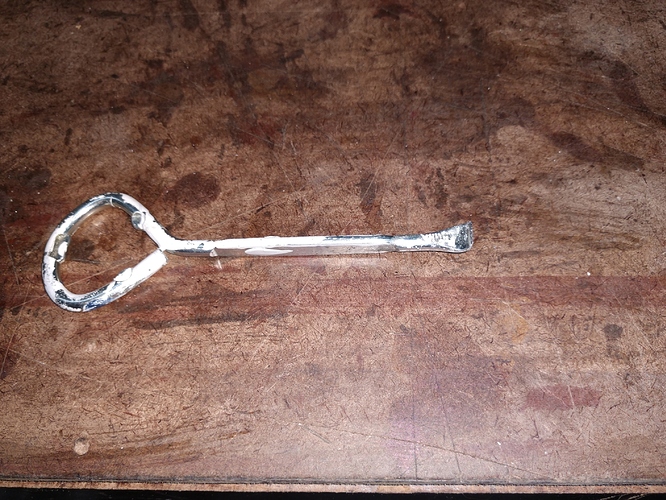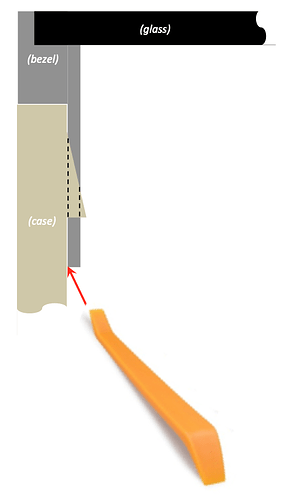I just wanted to put in my 2 cents here. Getting those tabs to unlock was painful. I didn’t quite understand how they were latched. The idea of using a paint can opener was great except it wasn’t sharp enough to get behind the tab. I ground one down and it grabbed the tab without a hitch. Now in my Glowforge toolbox.
Thank you for the tip, @jglazer63! I’ve added a note to the main post.
@ScottW514 I am in the middle of cleaning my exhaust fan. I have pulled the foil tape, but I am confused on the plastic tab issue. I pull or pry them toward the inside of the GF in order to “unhitch” them from the rectangle shown on picture 5?
Sorry to bother you, but I’d sure like some “experienced” help.
Thank you.
@jglazer63 and @ballewd
If you can help, as I see you have the experience too… please feel free to chime in on my behalf. I sent the following note to Scott:
I am in the middle of cleaning my exhaust fan. I have pulled the foil tape, but I am confused on the plastic tab issue. I pull or pry them toward the inside of the GF in order to “unhitch” them from the rectangle shown on picture 5?
Sorry to bother you, but I’d sure like some “experienced” help.
Thank you.
I actually just gone done cleaning mine. The tabs you see are attached to the top glass, and need to be pried towards the inside of the GF to release from the bottom of the case. *What I did was hook a pair of bent-nosed tweezers behind each tab, and then from the outside insert a spudger-like object through the gap between the top glass and the siding of the machine (anything relatively long and thin will do). Repeat for the other two tabs and the top should pop up easily.
*This could potentially permanently bent or dent the outside of your case
It took me a while to figure out what the tabs were and how to pry them. See if you can get a camera in there and take a photo of the holes. You might be able to get a better idea. You definitely need some sort of small angled tool to grab them and pull them.
As an aside, if your warrantee is up anyhow, you can do what I did and just cut the finger guard off the back of the exhaust fan so I can easily clean the fan from the outside and forego ever opening this up again.
See my post in "First modification to my basic to see the tool I used. By inserting the sharpened edge under the tab and pushing down, the tab is deflected inward while the heel of the tool pushes out on the case.
The case wall is thin and is given rigidity by the top. There won’t be any damage to the case if you are careful.
See my thread “First Modification to my Basic”
@Drelleum @jglazer63 Thank you to all who answered my call for help. All went well and we are now “cage free” and printing up a storm!
Thank you!
you too @PTL ! Thanks
I used an auto trim removal tool like the one below. Dodn’t need to pull, just wedge it up between the clip attached to the glass and the retainer on the side of the case, where shown in the 2nd pic.
I did just that. Didn’t know this forum was here at the time. Cut the "finger guard " completely out, too. Woodcrafter’s store sells woodshop dust collector fittings that are easily modified into an external fan casing, and I used Scotchlock splices to extend the fan wiring back to the power pins inside.
Has anyone removed the fan completely / replaced it with an empty fan housing? If so, how much does it cut the noise on a pro unit? I’ve had mine hooked up to an external extractor for a long time, and even with the compact filter toggle on in the software, it still is pretty loud (and high pitched).
There are a few people who have. If you have a strong enough exhaust fan that can move at least 250 CFM (or so), you should be OK.
I have a BOFA extractor, so really the fan is probably obstructing the air flow more than helping. The question is more of how good removing that fan is for cutting the noise.
I removed both the exhaust fan and the fan grill. I have a booster with a 4" inlet and a 10 " impeller within 2 feet of the machine.
The stock exhaust fan runs @ 13,000 RPM and the booster runs at a fraction of that. The noise reduction is quite dramatic, and the airflow smoother without the obstruction of the fan grill.
My advice is do yourself a favor and lose the stock fan.
Removing the fan is really a dramatic reduction in noise. It went from something that was uncomfortable to be in the same room as, to something you could be on the phone while next to and the other person would probably not notice. This is the noise level they advertised when the funding campaign started, and honestly I think they need to add an option where you order a fan-less glowforge and external filter unit.
Thanks for the guidance for how to remove the lid(s)
Has anyone used a relay to control their external fan? I would like to remove the stock fan and use an external 115vac blower, but I wanted to use the GF’s 12vdc to actuate a relay that would than turn on the blower. I don’t have much experience with PWM, so I’m not sure exactly how that works, but does the GF turn on and off the 12vdc power each time a cut starts?(in which case I can use that to pull in my relay) Or is the 12vdc always on, and the PWM determines when the fan runs?(in which case I cannot use it to run the relay…)
Basically I want my external fan to come on when the cut starts (like the stock), and shut off when it ends (or a little after, once I install a delayed relay circuit).
I got stuck on Step 2 ![]()
I cannot get anything under the locking metal under the 3 covered holes.
I am using a Pro - I wonder if this is different to yours.
This is helpful - I just ordered myself a set of these - now I can remove all the trim on my neighbors cars too.

